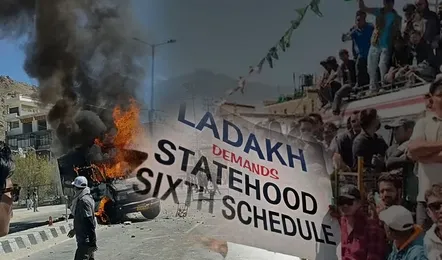The High Cost Of Being Seen In The Himalayas
Ladakh rose in protest over identity rights.
By Iffat Aurooj
The morning in Leh was colder than usual when the sound of ambulance sirens cut through the thin September air. Two elderly hunger strikers, who had been fasting for weeks, were rushed to the hospital. Their bodies had given way long before their will.
Within hours, the streets filled with young protesters carrying banners and stones. Vehicles burned, government buildings were attacked, and police fired tear gas to push the crowds back.
Four people died and more than eighty were injured before nightfall.
The uprising began with an act of resistance when Sonam Wangchuk, a Ladakhi engineer and environmentalist known for his work on climate adaptation, began a hunger strike on September 10. His demands were clear: statehood for Ladakh, constitutional protection under the Sixth Schedule, separate Lok Sabha seats for Leh and Kargil, and job reservations for locals.
His fast stretched into a second week under harsh Himalayan conditions and gave the movement a moral center.
For days, the supporters kept vigil as Wangchuk's health weakened. Then came the turning point.
Tsering Angchuk, 72, and Tashi Dolma, 60, fellow strikers who had refused food alongside him, collapsed and were hospitalized. Their sudden decline felt like a collective wound. Young people, already frustrated by years of stalled negotiations and vague promises, surged into the streets.
What began as a plea for rights hardened into a pressing fight for survival and recognition.
Wangchuk ended his fast that evening with an emotional appeal for calm. He called it the saddest day of his life and said the path of nonviolence he had championed now felt fragile. But he insisted that the demands remained unchanged.
Life in Leh has since narrowed under curfews and prohibitory orders that ban gatherings of more than five people. Security forces patrol the bazaars and checkpoints stand at street corners. The administration points to ongoing talks with the Leh Apex Body and the Kargil Democratic Alliance, who will meet a High-Powered Committee on October 6.
Many Ladakhis say these talks have delivered little beyond delays. Statehood, they reckon, is a shield for land rights, fragile ecosystems, and jobs for young people in the strategic zone.
The story unfolding in Ladakh is part of a larger pattern across South Asia. In Nepal, Gen Z protests have filled city squares with demands for accountability and better governance. There, the institutions exist but fail to perform. Ladakh faces a sharper dilemma.

Legal Disclaimer:
MENAFN provides the
information “as is” without warranty of any kind. We do not accept
any responsibility or liability for the accuracy, content, images,
videos, licenses, completeness, legality, or reliability of the information
contained in this article. If you have any complaints or copyright
issues related to this article, kindly contact the provider above.
Most popular stories
Market Research

- Alchemy Markets Launches Tradingview Integration For Direct Chart-Based Trading
- Next Generation Management Corp. (OTC: NGMC) Announces Strategic Shift Toward Digital Commerce Acquisitions
- Falconx Launches First Ethereum Staking Rate Forwards (Fras) Referencing Treehouse's TESR
- Everstake Expands Institutional Solana Services With Shredstream, Swqos, And Validator-As-A-Service
- T-REX Launches Intelligence Layer To Fix Web3's Value Distribution Problem
- Ethereum-Based Defi Crypto Mutuum Finance (MUTM) Raises Over $16 Million With More Than 720M Tokens Sold






















Comments
No comment